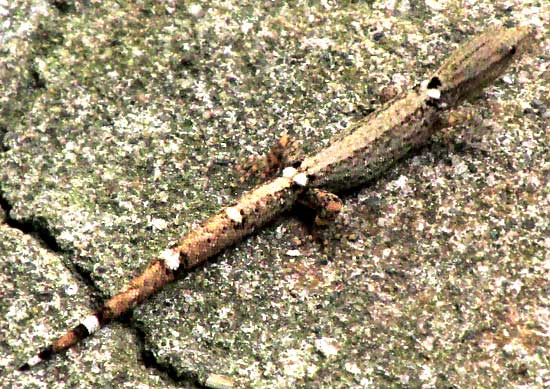Excerpts from Jim Conrad's
Naturalist Newsletter
from the November 9, 2018 Newsletter with notes from a camping trip into northern Guatemala's Petén department
COLLARD DWARF GECKO
A month ago, on October 2 when I was camping on the eastern side of the town of Sayaxché, in Rosario National Park in northern Guatemala's Petén district, the daily afternoon downpour was just beginning as I got out of the tent to move it more toward the thatch-roofed shelter's center. At that moment a tiny lizard ran from beneath the tent's edge, across the concrete floor. I had just enough time to snap a picture when he paused a moment before plunging over the edge into a crack in the shelter's foundation. Below, you can see him:

He was small, about the length of my small finger. I didn't even know he bore those interesting black-edged white blotches until the photo appeared on the laptop's screen. With such unusual field marks, he was easy to identify the little fellow as the Collared Dwarf Gecko, SPHAERODACTYLUS GLAUCUS, distributed from southern Mexico south to Honduras. This is a small distribution area, and not much information is available about the species on the Internet, so I'm glad to document that they like to snuggle under tent edges in camping shelters.
In Amphibians and Reptiles of Northern Guatemala, the Yucatán and Belize. Jonathan Campbell, who uses the common name Spotted Bark Gecko, tells us that in natural situations the species is found under loose bark, among epiphytes growing in trees, and in crevices in vertical rocky outcroppings. The shelter's foundation crack was close enough to the latter environment. I read elsewhere that in houses, where it may camp in thatch roofing, sometimes it's both prey and competition for the Common House Gecko.
Campbell reports it as present in the northern Yucatan Peninsula, but I've never seen it there. All my abodes in the Yucatan have been occupied by noisy House Geckos, so maybe they eat any Collard Dwarf that comes around.